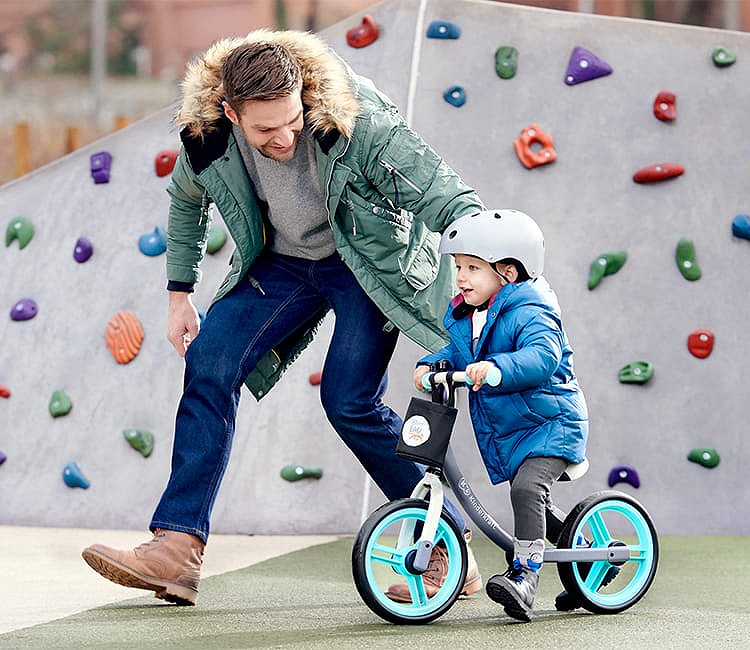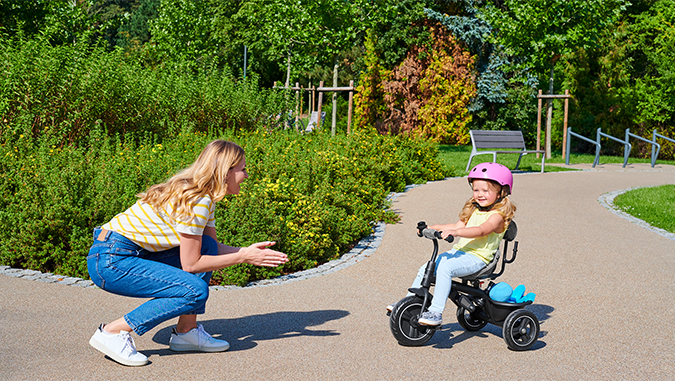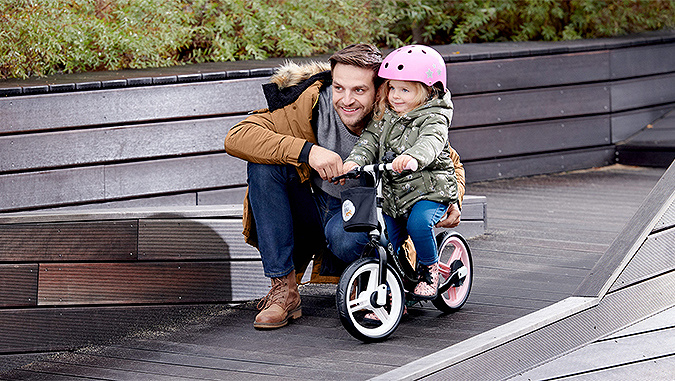Bicycle for a child - how and which one to choose
8 min

Riding a bicycle is great fun for a child, but also encourages them to spend time outdoors actively. Every parent wants their child to have fun on two wheels. However, learning to ride a bike is a complex and not easy process. It's a good idea to start with a ride-on or a balance bike, so that your child can easily switch to a bike with pedals. But how to choose a bike according to the age and skills of a child? What should we pay attention to when buying the perfect model? We suggest!
When should a child have a bike?
Each child develops at its own individual pace. Some will start walking on their first birthday, others even a year later. For this reason it is difficult to give a single, universal age when a child should start their adventure with a bike. Some manufacturers recommend that your baby starts riding a balance bike when it is 18 months old. Don't be guided by this recommendation, but only by your child's abilities and the level of its development. A toddler must already be able to walk confidently and keep its balance.

Which bike to buy?
It all depends on the expectations of both parents and toddlers. Among bicycles for the youngest children there are basically three types: ride-on toys, tricycles and balance bikes. Ride-on toys have wide seats, a neat handle and children ride them by pushing their legs against the floor. Tricycles, on the other hand, are a good choice at the very beginning of a child's adventure with bicycles; some of them are suitable for use even by 9-month-olds, such as our EASYTWIST with its rear-facing function. Toddlers feel safe and stable in them, and at the same time they are slowly adapting to the way this type of equipment functions. Tricycles can be found in forms of balance bikes and bikes with pedals. However, remember that pressing the pedals may sometimes be too difficult for your child and this may lead to discouragement. Balance bikes, on the other hand, develop the sense of balance - they are ideal for children who not only walk, but already run. Riding them will make it much easier for children to move to a larger model with pedals and attachable wheels.
In Kinderkraft's offer you will find both small tricycles, which will prove to be the first bikes for toddlers - such as CUTIE - and balance bikes - of different sizes, colors and materials. We also have a special bike - 4TRIKE - that grows with your child, because it's a tricycle, but it can turn into a two-wheeler balance bike, or even a bike with pedals.
How to choose the size of the bike for the height of the child?
When choosing a bike for a child, there are several things to consider, first of all, height, although you should not forget about its individual physical abilities as well. Manufacturers like to combine the age and height of a child with the appropriate size of the wheels and frame - this is what affects the size of the bike. Tables that tell you what size will be right for your child are approximate and it's always best to try the bike on. The rule of thumb is that your child should be able to put his or her feet fairly comfortably on the ground when sitting on the saddle. Unless you buy a bike with attachable wheels, then it is enough that a toddler is able to rest their toes on the ground.
An extremely important, and sometimes overlooked dimension is simply the height of the child's crotch - this parameter is particularly important in the case of balance bikes. How to measure it? The easiest way is to place the child in socks on a flat surface near a wall. Then place a small book between the legs as high as possible. The top edge of the book will determine the height of the crotch. With this information, you will know if your child is able to get on and off the bike.
What type of frame should I choose?
The type of frame should be chosen according to the child's height and the height of the crotch should also be taken into account so that the child can get on the bike easily. It is better to choose a bike with a slightly lower frame, as this will make it easier for the child to get on and off the bike. This does not matter only for bikes with side wheels. Such bicycles for children are stable, they will not wobble, so the child can freely sit on them. Frame sizes are usually given from 11 inches. Smaller bikes do not have this size - they are suitable for children up to 5 years of age or up to a crotch height of 53 cm.
What size wheels should I choose?
Wheel sizes start from 12 inches - such wheels are designed for children who are about 1 meter tall. The bigger the child, the bigger the wheel size should be. However, remember that the height of your child's crotch should also be taken into account. Other wheel sizes are larger by 2 inches - 14, 16, 18, 20, 22, 24, but 14 and 18 are rare. The largest bicycles for children - with 24-inch wheels - are designed for children measuring from 130 to 145 cm.
Bike with side wheels?
Children's bicycles with side wheels is a new challenge for kids, who so far have ridden only balance bikes. It is a "real" bike - with pedals, chain, brakes, etc. The transition to such a bike is a big change, and not every child may be ready for it, so don't force your child to switch too quickly. But not every child needs an intermediate stage in the transition from a balance bike to a two-wheeler.
When should you suggest a bike with side wheels? For example, when they ask for it themselves. There is a good chance that if a child doesn't want to go for a more "adult" model, they won't be happy about the change inspired by the parent. Remember that for toddlers, a balance bike is pure fun, while a child's bike with pedals can be tiring- especially at the beginning, when pushing the pedals is quite an effort.
It also doesn't always make sense to fit side wheels. Kids who excel at balance bikes are likely to have their balance developed well enough to switch to a two-wheeler pedal bike without much trouble. For your peace of mind, you can install a special learning bar to insure your child.

Bicycle accessories - what is worth buying?
If the model of bicycle you bought does not have such elements as fenders or a bell, definitely invest in them. Fenders will protect your child and their clothes from mud and puddles, and the bell will become an important element of warning other road users. And at the same time it can be an attractive gadget.
Today the offer of accessories for children's bicycles is extremely wide. With the help of various gadgets, a child can personalize the bike in any way he or she likes. Beads for spokes, discs for wheels, stickers, mascots and many, many others can help them in this. However, some of the accessories have a legitimate practical function that should be seriously considered.
When your child is starting out on a pedal bike, it's a good idea to make sure your child feels stable, as well as your own comfort of feeling safe. For this purpose, side wheels and special handles, thanks to which a parent can help to keep the child safe, will prove to be very useful.
A special bicycle flag, thanks to which the child is additionally visible on the bicycle route, also contributes to the child's safety. Bicycle flags are especially useful when a child starts to ride a bicycle by themselves or when you plan a longer trip with the whole family.
It is not unreasonable to consider buying baskets, carriers or special saddlebags - even for toddlers. Even though you probably don't plan to load a toddler's bike with big bags, a place to store things can make a bike more attractive in the eyes of a child. Firstly, it can make it more similar to the parent's bike, and secondly, a toddler will be happy to put some of their own small items - such as toys or a water bottle.
What else to pay attention to when buying a bicycle?
First of all - safety! When buying a bicycle for your child, you should bear in mind safety. The material from which the bike is made counts, as well as the stability and durability of the structure. Also have a look at whether the bike has no protruding, dangerous elements, whether the bearings are of good quality and the frame is not damaged.
If safety is important, a helmet is the first priority! Without it every ride is very dangerous. A helmet primarily protects the head from injury caused by falls and impacts, as well as from hazards such as the sun, insects or branches - especially when a toddler develops a bit more speed.
Some bicycles for children offer a set of different solutions that further promote the safety of toddlers. Small bicycle gloves that increase hand grip on the handlebars can be useful. Non-slip handles can be installed on the handlebars. Some models even have handlebar locks to give your child more control over their path of travel. This is especially important with balance bikes, so the risk of sudden turns and thus falls is greatly reduced.
Learning to ride a bicycle. What should we keep in mind?
First of all you need to take care of safety. Helmet - this is the basis, as we wrote above. But also important is the place where you will practice. Ideally, if you can ride in your own backyard, and if not, then choose a place that a child knows well. Preferably a road with a smooth surface, though not necessarily level. A road that slopes a bit will work well, so the bike will go downhill more easily and your child won't have to pedal hard.
When you're switching from a balance bike to a pedal bike, make sure that your child definitely wants one. Trying to persuade your child can only have the opposite effect - they’ll get tired and discouraged, and won't even want to hear about a real bike for a long time. If a toddler wants to move to a more adult model, take care of their comfort and safety. The bike has to be the right size, may have additional side wheels and may be equipped with a bar so that a child can be supported by a parent.
Also remember about your own positive attitude and huge reserves of patience. Learning to ride a bike is a difficult process, requiring a child to overcome many inhibitions and fears. It's difficult for toddlers to coordinate balancing and pedaling at the same time; children instinctively look under their feet instead of ahead. The key in such a situation is for the parent to keep a cool head and not get irritated - otherwise they will stress a child further. You are there to support a child, encourage them and make them feel safe. So make sure you have large reserves of understanding and patience.
